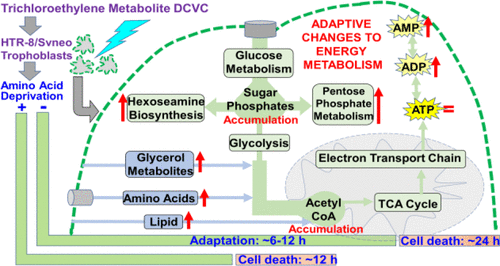当前位置:
X-MOL 学术
›
Chem. Res. Toxicol.
›
论文详情
Our official English website, www.x-mol.net, welcomes your
feedback! (Note: you will need to create a separate account there.)
Exposure to Trichloroethylene Metabolite S-(1,2-Dichlorovinyl)-L-cysteine Causes Compensatory Changes to Macronutrient Utilization and Energy Metabolism in Placental HTR-8/SVneo Cells.
Chemical Research in Toxicology ( IF 3.7 ) Pub Date : 2020-01-17 , DOI: 10.1021/acs.chemrestox.9b00356 Elana R Elkin 1 , Dave Bridges 2 , Sean M Harris 1 , Rita Karen Loch-Caruso 1
Chemical Research in Toxicology ( IF 3.7 ) Pub Date : 2020-01-17 , DOI: 10.1021/acs.chemrestox.9b00356 Elana R Elkin 1 , Dave Bridges 2 , Sean M Harris 1 , Rita Karen Loch-Caruso 1
Affiliation

|
Trichloroethylene (TCE) is a widespread environmental contaminant following decades of use as an industrial solvent, improper disposal, and remediation challenges. Consequently, TCE exposure continues to constitute a risk to human health. Despite epidemiological evidence associating exposure with adverse birth outcomes, the effects of TCE and its metabolite S-(1, 2-dichlorovinyl)-L-cysteine (DCVC) on the placenta remain undetermined. Flexible and efficient macronutrient and energy metabolism pathway utilization is essential for placental cell physiological adaptability. Because DCVC is known to compromise cellular energy status and disrupt energy metabolism in renal proximal tubular cells, this study investigated the effects of DCVC on cellular energy status and energy metabolism pathways in placental cells. Human extravillous trophoblast cells, HTR-8/SVneo, were exposed to 5–20 μM DCVC for 6 or 12 h. After establishing concentration and exposure duration thresholds for DCVC-induced cytotoxicity, targeted metabolomics was used to evaluate overall energy status and metabolite concentrations from energy metabolism pathways. The data revealed glucose metabolism perturbations including a time-dependent accumulation of glucose-6-phosphate+frutose-6-phosphate (G6P+F6P) as well as independent shunting of glucose intermediates that diminished with time, with modest energy status decline but in the absence of significant changes in ATP concentrations. Furthermore, metabolic profiling suggested that DCVC stimulated compensatory utilization of glycerol, lipid, and amino acid metabolism to provide intermediate substrates entering downstream in the glycolytic pathway or the tricarboxylic acid cycle. Lastly, amino acid deprivation increased susceptibility to DCVC-induced cytotoxicity. Taken together, these results suggest that DCVC caused metabolic perturbations necessitating adaptations in macronutrient and energy metabolism pathway utilization to maintain adequate ATP levels.
中文翻译:

暴露于三氯乙烯代谢物S-(1,2-二氯乙烯基)-L-半胱氨酸导致胎盘HTR-8 / SVneo细胞中大量营养素利用和能量代谢的代偿性变化。
三氯乙烯(TCE)是数十年来用作工业溶剂,处理不当和应对污染的一种广泛的环境污染物。因此,接触三氯乙烯的时间继续构成对人类健康的风险。尽管有流行病学证据表明暴露与不良的出生结局,TCE及其代谢物S的影响有关胎盘上的-(1,2-二氯乙烯基)-L-半胱氨酸(DCVC)尚未确定。灵活高效的常量营养素和能量代谢途径的利用对于胎盘细胞的生理适应性至关重要。由于已知DCVC会损害细胞能量状态并破坏肾近端肾小管细胞的能量代谢,因此本研究调查了DCVC对胎盘细胞中细胞能量状态和能量代谢途径的影响。将人类绒毛外滋养层细胞HTR-8 / SVneo暴露于5–20μMDCVC中6或12 h。在建立DCVC诱导的细胞毒性的浓度和暴露持续时间阈值后,使用靶向代谢组学评估能量代谢途径的总体能量状态和代谢物浓度。数据显示葡萄糖代谢紊乱包括葡萄糖-6-磷酸+果糖-6-磷酸(G6P + F6P)的时间依赖性积累以及葡萄糖中间体的独立分流,葡萄糖中间体随时间而减少,能量状态适度下降,但在ATP浓度无明显变化。此外,代谢谱分析表明DCVC刺激了甘油,脂质和氨基酸代谢的补偿性利用,以提供进入糖酵解途径或三羧酸循环下游的中间底物。最后,氨基酸剥夺增加了对DCVC诱导的细胞毒性的敏感性。综上所述,这些结果表明DCVC引起代谢扰动,因此必须适应大量营养素和能量代谢途径的利用,以维持足够的ATP水平。
更新日期:2020-01-17
中文翻译:

暴露于三氯乙烯代谢物S-(1,2-二氯乙烯基)-L-半胱氨酸导致胎盘HTR-8 / SVneo细胞中大量营养素利用和能量代谢的代偿性变化。
三氯乙烯(TCE)是数十年来用作工业溶剂,处理不当和应对污染的一种广泛的环境污染物。因此,接触三氯乙烯的时间继续构成对人类健康的风险。尽管有流行病学证据表明暴露与不良的出生结局,TCE及其代谢物S的影响有关胎盘上的-(1,2-二氯乙烯基)-L-半胱氨酸(DCVC)尚未确定。灵活高效的常量营养素和能量代谢途径的利用对于胎盘细胞的生理适应性至关重要。由于已知DCVC会损害细胞能量状态并破坏肾近端肾小管细胞的能量代谢,因此本研究调查了DCVC对胎盘细胞中细胞能量状态和能量代谢途径的影响。将人类绒毛外滋养层细胞HTR-8 / SVneo暴露于5–20μMDCVC中6或12 h。在建立DCVC诱导的细胞毒性的浓度和暴露持续时间阈值后,使用靶向代谢组学评估能量代谢途径的总体能量状态和代谢物浓度。数据显示葡萄糖代谢紊乱包括葡萄糖-6-磷酸+果糖-6-磷酸(G6P + F6P)的时间依赖性积累以及葡萄糖中间体的独立分流,葡萄糖中间体随时间而减少,能量状态适度下降,但在ATP浓度无明显变化。此外,代谢谱分析表明DCVC刺激了甘油,脂质和氨基酸代谢的补偿性利用,以提供进入糖酵解途径或三羧酸循环下游的中间底物。最后,氨基酸剥夺增加了对DCVC诱导的细胞毒性的敏感性。综上所述,这些结果表明DCVC引起代谢扰动,因此必须适应大量营养素和能量代谢途径的利用,以维持足够的ATP水平。











































 京公网安备 11010802027423号
京公网安备 11010802027423号